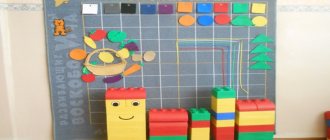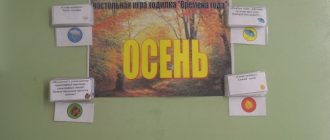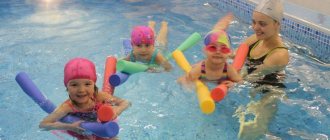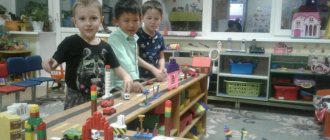Corner of role-playing games. Hospital
Yulia Tugusheva
Corner of role-playing games. Hospital
Role-playing games corner . Hospital ,
The group has created a comfortable subject-spatial environment that corresponds to the age and individual characteristics of children. The developmental environment has flexible zoning, which allows children, in accordance with their interests and desires, to freely engage in different types of activities at the same time, without interfering with each other. The areas of independent children's activity within the group do not overlap; there is enough space for children to move freely. All games and materials in the group are arranged in such a way that every child has free access to them. This organization of space allows preschoolers to choose interesting activities for themselves, alternate them during the day, and the teacher organizes the educational process taking into account the individual characteristics of the children.
The development environment of the group reflects the main directions of educational areas of the Federal State Educational Standard for Education: - cognitive development; — communicative and personal development; - speech development; — artistic and aesthetic development; - physical development.
The group room space is organized in the form of well-demarcated corners (development centers)
:
-corner for theatrical games; corner -music corner ; -book corner ; — a corner for role-playing games ; -mathematical games corner ; -a corner of nature and experimentation; -sports section ; -a corner for visual activities (drawing, modeling, appliqué, modeling)
;
- design corner ; - corner of privacy ;
Role-playing games corner , Hospital »»
The play area is equipped with attributes for role-playing games , selected taking into account the age characteristics of children. It includes: Didactic aids, visual aids, game set, Doctor, thermometer, syringe, bandage, cotton wool, pipette, phonedoscope, stadiometer, heating pads, children's honey. suit (robe and cap, bag with a cross, paper for writing down recipes + pencil.
All gaming materials and manuals are freely available to children.
Tasks:
Develop children's cognitive abilities,
To arouse in children an interest in the medical profession, to cultivate a sensitive, attentive attitude towards the patient .
To develop in children the ability to take on a role and perform appropriate game actions, to use honey during the game. tools.
Promote the emergence of role-playing dialogue.
The subject-development environment we have created allows us to ensure maximum psychological comfort for each child, create opportunities for the exercise of his right to freely choose the type of activity, the degree of participation in it, the ways of its implementation and interaction with others. This organization of the subject-spatial developmental environment of the group seems to us the most rational, since it takes into account the main directions of the child’s development and contributes to his favorable development.
When organizing a subject-spatial environment in a kindergarten, complex, multifaceted activities of all participants in the educational process are necessary. Further work involves searching for innovative approaches to organizing the subject-development environment in preschool educational institutions, as well as developing parents’ interest in this problem and motivating the desire for interaction.
Project “Plot-role-playing game “HOSPITAL”. project (middle group)
Municipal budgetary preschool educational institution "Kindergarten No. 18 "Swallow"
Project “Plot-role-playing game “HOSPITAL”.
Prepared by:
Burykina E.A.
Relevance of the topic:
In the life of a preschool child, play occupies one of the leading places. For him, play is the main activity, a form of organizing children’s lives, and a means of comprehensive development. Every kindergarten teacher is faced with the task of creating a friendly, organized team and teaching children to play.
Plot-based role-playing games help children learn, take into account the opinions of their comrades, take into account each other’s capabilities and desires. They teach them to respect each other’s interests and rights.
Through role-playing games, educational, educational, and developmental tasks are solved. In the process of role-playing games and preparation for them, a preschool child exhibits the following activities: gaming, communicative, labor, motor, cognitive-research, musical-art, perception of fiction and productive.
Type of project: group, educational.
Project duration: short-term (1 month).
Project participants: teachers, children, their parents, music director.
Age of children: middle group.
Justification of the problem:
- children’s inability to play role-playing games, follow the rules and course of story games;
- insufficient knowledge of children and parents about the structure of role-playing games and ways of presenting them to children.
The goal of the project: to develop in children and parents the interest and ability to play role-playing games.
Tasks:
- Teach children to play role-playing games, following the rules and course of the game, developing their interest and active participation.
- To acquaint parents with the structure of a role-playing game, its educational objectives, and ways of presenting it to children.
- Enrich, expand and systematize children’s knowledge about the medical profession and the work of the clinic.
- Create your own gaming environment for your intended purpose.
- To contribute to the formation of the ability to creatively develop game plots.
- Cultivate respect and gratitude for the work of doctors and nurses. To arouse children's interest in the medical profession. Cultivate a sensitive, attentive attitude towards the patient, kindness, responsiveness, and communication culture.
Project methods:
- Visual
- Gaming
- Verbal
Activities:
- speech;
- gaming;
- musical;
- creative;
- figurative;
- productive;
- theatrical;
- joint and independent;
- educational;
- familiarization with fiction;
- acquaintance with art;
- familiarization with the surroundings;
- formation of temporary concepts;
- development of communication abilities.
Equipment and materials:
- attributes for the game "Hospital": doctor's coat, nurse's coat, caps, disposable syringes without needles, plastic bottles, jars, droppers, children's phonendoscope, toy thermometer, yellow paper mustard plasters, bandage, napkins (cotton wool), prescription forms, handbag for a doctor with a cross;
- doctor's kit;
- illustrations, pictures;
- selection of works of art about the profession of a doctor, a hospital;
Integration of educational areas: Socialization, cognition, communication, safety, work, reading fiction.
Implementation deadline: January
Expected Result:
- At the end of the project, children began to use the role-playing game “HOSPITAL” more often for games and played it with great interest and success.
• Parents were introduced to the structure of a role-playing game, its educational objectives, and ways of presenting it to children. Parents were interested in the topic and received new and useful information, successfully tested on their children, which is clear from conversations with parents on this topic.
Project stages:
1.Preparatory stage:
- Study educational and methodological literature, articles in the magazines “Preschool Education”, “Hoop”, on teaching children role-playing games.
- Prepare equipment for decorating the “hospital”
- Prepare substitute objects for the child’s independent play.
- Design a wall newspaper based on the role-playing game “Hospital”.
- Excursion to the medical office of the kindergarten.
- Observing the work of a nurse or doctor (listens with a phonendoscope, looks at the throat, asks questions).
- Conversation with children “How I went to see a doctor with my mother”
- Puppet theater “Doctor Aibolit”. Reading literary works about the work of a doctor: (B. Zhitkov “Collapse”, S. Marshak “Ice Island” Y. Zabil “Yasochka Got a Cold”, E. Uspensky “Playing in the Hospital”, V. Mayakovsky “ Who to be?").
- Conversations about the doctor's profession using illustrations and looking at paintings.
- Manual labor: making a thermometer, phonendoscope, mustard plasters for the game “hospital”.
- Listening to K. Chukovsky’s fairy tale “Doctor Aibolit” in a recording.
- Modeling “Gift for sick Yasochka.”
- Making game attributes with children with the involvement of parents (robes, hats, recipes, medical cards, coupons, etc.)
2.Main stage.
- Help create a game environment, establish interaction between those who have chosen certain roles.
- To develop in children the ability to play according to their own plans, to stimulate children’s creative activity in play.
- To form friendly relationships in the game, a sense of humanism, activity, responsibility, friendliness.
- Reinforce previously acquired knowledge about the work of a doctor.
3. Final stage.
- Organizing a photo exhibition for parents “By playing we learn, by playing we learn! ", where you can see what role-playing games children play in the group.
• Visual information “Plot-role-playing game in a child’s life.”
Options for the role-playing game “Hospital”:
“The doll Katya is sick.”
Pedagogical idea: to teach two children to take on the roles of mother and doctor, to act adequately to the role, to bring the role taken to the end of the game. Teach children the actions of a doctor: examine the patient, take the temperature, look at the throat, listen with a straw; use attributes in the game for their intended purpose, accompany your actions with speech, and conduct simple dialogues. Cultivate a feeling of caring for the patient, convey this through gentle speech.
Game content:
A doll with a bandage is lying in bed. The teacher asks the children what could have happened to the doll? Why doesn't she get out of bed? Why is her throat tied? Listens to the children's answers, gives comments about them, then clarifies whether the children know what to do when someone gets sick? Who treats children and adults? Invites children to think and say who should be called to the sick doll.
The teacher suggests playing at the clinic. He assigns roles and briefly instructs about who should do what during the game. In the first lesson, children act on verbal prompting.
As the plot develops, the mother (child) calls a doctor at home by calling the clinic: “Hello, my daughter is sick. Can I call a doctor? “The doctor (child) replies that he will come to the patient. A doctor arrives with a medical bag, wearing a robe and cap. An adult helps develop a dialogue between mother and doctor about the doll’s illness. Then the doctor measures the temperature, listens, looks at the throat, and gives recommendations for treatment (drink pills, gargle). An adult helps the child doctor conduct a dialogue with the doll and mother. Mom gives her daughter pills and drinks. He speaks affectionately to his daughter. The teacher helps the child conduct a conversation with the doll and perform play actions.
"Dad calls the doctor."
Pedagogical intent: to teach children to take on the roles of mom, dad and doctor, to act adequately to the role, to bring the role they take to the end of the game. Continue to teach the actions of a doctor: examine the patient, measuring the temperature, looking at the throat, listening with a straw: use the attributes in the game for their intended purpose; accompany your actions with speech, conduct simple dialogues. Cultivate in children a sustainable interest in play and friendly relationships. Teach to treat the doll like a daughter.
Game content:
The teacher suggests playing “doctor”. The roles of the doctor, mother and father are assigned, and the actions of the participants are discussed.
The adult helps the children start the game by assigning roles “in the family”: dad calls the doctor by phone to see his sick daughter, and mom sits next to the child, strokes her on the head, gives her a drink, etc.
A doctor comes in a white coat with all the attributes. Dad meets the doctor at the entrance and invites him to wash his hands, and takes the doctor to his daughter. The doctor asks the daughter what is hurting her, examines her, puts a thermometer, listens, looks at her throat. As the game progresses, the teacher constantly helps the children perform actions and accompany them with speech, addressing the children according to their role, for example: “Mom, ask the doctor how you should treat your daughter? “or: “Doctor, tell mom and dad what temperature their daughter has: high or normal,” etc.
In the next lesson, a child can play the role of the patient, thus four children are included in the game, etc. as the plot develops. It is advisable that all children take turns playing different roles.
"Ambulance".
Pedagogical intent: to strengthen children’s ability to take on the roles of a doctor, driver, mother, father, patient, and to act according to the role taken. Learn to adequately use the attributes of the game, consolidate their purpose and actions with it.
Game content:
In a short introductory conversation, the teacher talks about what should be done if a person is seriously ill or falls ill at night, and how he can be helped. Introduces the plot of the game to children. Helps distribute roles. Starting the game, the teacher tells the children that dad is sick and cannot get out of bed to go to the doctor.
The adult asks the children what should be done in this case? Children, in accordance with the proposed plot, guess that they need to call an ambulance. A daughter or son calls an ambulance by phone, the ambulance officer on duty accepts the call and informs the doctor. The doctor arrives, rings the doorbell, my mother opens it, invites me to go into the apartment, wash my hands, gives me soap and a towel. The doctor washes his hands and goes to the patient. An adult helps, if necessary, to conduct a dialogue between the patient and the doctor, to accompany the actions with speech. As the game progresses, the doctor examines the patient, puts him on a thermometer, and offers to give him an injection. When performing this action, the teacher can provide assistance (showing, explaining the actions). If the doctor tries to leave immediately, the teacher draws attention to the fact that it is advisable to observe the patient, sit by his bed, measure the temperature again, etc.
The doctor sits for some time at the patient’s bedside, asking him questions about his health. Family members see him off and say goodbye. The doctor leaves by car.
“An ambulance takes the Katya doll to the hospital.”
Pedagogical intent: to continue to teach children to take on the roles of a doctor, driver, mother, father, patient, to act according to the role taken, to adequately use the attributes of the game, to consolidate their purpose. Continue to cultivate a polite attitude towards each other and sympathy for the patient.
Game content:
The teacher offers a new plot of the game, explains it in detail to the children, and helps distribute roles.
An adult, together with his children-parents, is worried about the illness of the Katya doll and suggests calling an ambulance doctor. Mom (child) calls the doctor by phone. The doctor answers that he leaves, gets into the car, the ambulance driver drives the car, drives away. Dad meets the doctor, offers to wash his hands and takes him to his sick daughter. Mom meets the doctor at her daughter’s bedside and answers the doctor’s questions. The doctor examines the patient, listens, takes the temperature, feels the stomach, etc. The doctor offers to take the daughter to the hospital. The mother takes her daughter in her arms, gets into the car with the doctor, and they go to the hospital. Dad stays at home, puts everything in order, prepares dinner, etc. In the hospital, where mom and the sick doll Katya come, there are 2-3 beds on which the “sick” dolls lie. The doctor meets the arrivals, takes Katya and puts her to bed, calms her mother down, invites her to come to the hospital with her dad tomorrow. Mom is leaving. The doctor gives Katya medicine, etc. The parents call the hospital and find out about Katya’s health.
During this game, you can teach children to “visit” patients in the hospital, walk with them, help the nanny feed sick dolls, etc.
“The doll has recovered.”
Pedagogical intent: to introduce children to a new plot, to reinforce the doctor’s game action: take the temperature, examine the throat, listen with a straw, etc. Continue to teach children to accompany their actions with speech, to conduct simple dialogues.
Contents of the game.
A short conversation about the work of a doctor in a clinic, the distribution of roles.
As the game progresses, mothers with their daughters and sons (dolls) come to see a doctor at the clinic.
The doctor takes turns seeing visitors. Mom with a doll comes to the doctor and says hello. The doctor asks questions about the child’s health, looks at the throat, takes the temperature, listens, etc. All actions are accompanied by speech, the teacher helps organize dialogues, directing the doctor’s actions and questions, for example: “Doctor, look at the throat, is it not red?” After inspection and recommendations, they say goodbye. The next mother enters with her child and so on (2-3 children).
This plot can be played out over several games until all the children have played the role of a doctor and parents of sick children.
"Doctor and nurse."
Pedagogical idea: to introduce children to the role of a nurse, her responsibilities, work actions: giving injections, putting drops in the eyes, ears, putting mustard plasters, compresses, lubricating wounds, bandaging. Fix a chain of game actions between the doctor, the mother who came to the appointment with the child, the doctor and the nurse, in which the doctor gives orders to the nurse. Continue to teach how to use attributes, introduce substitutes. Continue to work on activating children's vocabulary.
Game content:
In order for learning new game actions to take place in the context of the game, the teacher takes on the role of a doctor. Brief introduction by the teacher, explanation of the course of the game, distribution of roles.
A doctor and a nurse are sitting at a table in a clinic. Nearby is a cabinet with medical instruments. Visitors sit on chairs in front of the office. The patient enters. The doctor asks him questions, clarifies what hurts, turns to the nurse with a recommendation on what needs to be done, for example: “Please wash the wound, lubricate it with iodine and bandage it.” The patient approaches the nurse, she (he) carries out the doctor’s orders. The doctor looks and helps if necessary. Then the doctor invites the patient to come the next day for procedures with the nurse. The patient thanks and leaves. The doctor calls the next one (2-3 visitors).
During subsequent games, the registry is turned on. Patients first come to the reception desk, take a card, then go to see a doctor and nurse. Gradually, the nurse’s “office” is equipped separately from the doctor’s office, additional treatment rooms are introduced, etc. Thus, the game expands and deepens in content.
"Pharmacy".
Pedagogical intent: to introduce children to the role of a pharmacist, cashier, and pharmacy visitors, to teach how to perform game actions, and to follow their sequence.
Materials: cash register, “money”, a pharmacy display case with various medicines and patient care items, personal hygiene items, a pharmacist’s white coat, recipes, pictures depicting medications, patient care items.
Game content:
The teacher talks with the children about the last excursion to the pharmacy. He remembers what he saw in the pharmacy, who works there, what he does and how, who comes to the pharmacy, what is needed to be able to buy medicine, etc. The adult invites the children to equip the pharmacy and place everything they need there. Children do this together with the teacher. Distribution of roles: an adult takes on the role of a pharmacist, invites some of the children to be a cashier, and the rest - visitors.
The pharmacist-teacher stands behind the display window, the cashier sits at the cash register. Visitors enter, each holding a doctor’s prescription, money, and a bag. They go to the display window and see if the medicine they need is there. The pharmacist helps them with leading questions, gives recommendations, and leads children into a conversation about medications and their purposes. Children take turns receiving checks at the cash register (cards with mugs, go to the pharmacist, take medications. The adult makes sure that all children voice their actions, for this he uses both direct and indirect questions.
In the next game, the role of the pharmacist is assigned to one of the children, and the teacher becomes a visitor and, together with the children, buys medicines, talks with them, etc.
Game situations: “At an appointment with an ENT doctor,” “At an appointment with a surgeon,” “At an appointment with an ophthalmologist,” etc.
An ophthalmologist checks vision using a table, writes a prescription for eyes, or a prescription for glasses. Patients buy glasses at the pharmacy (without lenses).
An ear-nose-throat doctor looks at the neck, tongue, and ears. Measures temperature and gives appointments for procedures. The nurse is warming up.
"Hospital".
The patient is admitted to the emergency room. The nurse registers him and takes him to the room. The doctor examines patients, listens carefully to their complaints, asks questions, listens with a phonendoscope, measures blood pressure, looks at their throat, and makes a prescription. The nurse gives medications to patients, takes temperatures, gives injections and dressings in the treatment room, treats wounds, etc. The nurse cleans the room and changes the linen. Patients are visited by relatives and friends.
Application
Materials for the “Health Corner” stand; methodological development on the topic
Serous viral meningitis
Serous viral meningitis is the most typical and severe form of enteroviral damage to the central nervous system.
The source of infection is patients and virus carriers. Some insects (for example, ticks) can act as carriers of infection.
Symptoms: The disease begins acutely, with a rise in temperature to 38-40 degrees, severe headache, dizziness, vomiting, sometimes with pain in the abdomen, back, and convulsions.
If similar complaints appear, it is necessary to urgently isolate the patient, because it is a source of infection for others, and consult a doctor.
Considering the possible routes of transmission, personal prevention measures should consist of following the rules of personal hygiene (washing hands before each meal), maintaining a drinking regime (boiled water, bottled water), carefully processing the fruits and vegetables consumed and then rinsing them with boiling water. You should swim in specially designated areas and do not swallow water. Do not wash vegetables and fruits in open water. During an increase in incidence, you should avoid visiting public events, places with a large number of people (public transport, cinemas, etc.). We recommend wet cleaning of residential premises at least 2 times a day and ventilation of the premises.
Under no circumstances should a child with any manifestations of the disease be allowed to attend an organized children's group (school, preschool institutions).
Clinically, the disease can begin with symptoms similar clinically to an acute respiratory viral infection (sore throat, runny nose, general weakness, which is accompanied by a rise in body temperature). Therefore, if a case of illness accompanied by these symptoms appears in the family, it is necessary to isolate the patient in the apartment, allocate separate dishes, not allow children near the sick person, one of the family members should take care of him, cover his nose with a disposable tissue when coughing and sneezing (use once), carry out routine cleaning using disinfectants, and regularly ventilating the premises.
According to sanitary doctors, there are no clustered foci of enterovirus infection in the region. According to the regional department of Rospotrebnadzor, as of July 18, 38 cases of disease due to enterovirus infection were registered in the region, of which 27 cases of serous meningitis and 11 of herpangina. It is emphasized that the cases of the disease are not related to each other and no outbreaks of group morbidity have been registered. Most of the sick did not follow the rules of personal hygiene, used unboiled water for drinking, and fruits and vegetables were not treated with boiling water before consumption.
The reason for the rapid spread of infection is due to the fact that the clinical forms of enterovirus infection are varied. This is due to the large number of pathogens that can cause the disease. Enterovirus infection can occur in the form of mild forms of the disease, such as conjunctivitis, pharyngitis, gastroenteritis, three-day fever, herpangina. In more severe cases, encephalitis and serous meningitis are recorded.
At the first sign of an infectious disease, you must contact a medical facility!
YOU NEED TO REMEMBER FOREVER:
THE KEY TO HEALTH IS CLEANITY!







